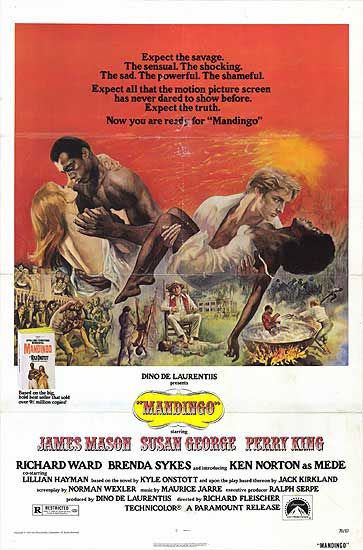 “Mandingo” is one of the worst films to slither through the grindhouse circuit of the ‘70s. The film was more than likely not meant to play on those screens, and one would imagine that Paramount and the Dino De Laurentiis Company had delusions of grandeur while making this epic of trash. You can tell that simply by the VHS box of the film, which is a variation on the old posters for “Gone With the Wind.” However, the result is a film with absolutely no redeeming value, except the fact that this train wreck of a movie manages to hold your attention. Your brain will want to bail out, but your eyes can’t help but stay glued to the screen.
“Mandingo” is one of the worst films to slither through the grindhouse circuit of the ‘70s. The film was more than likely not meant to play on those screens, and one would imagine that Paramount and the Dino De Laurentiis Company had delusions of grandeur while making this epic of trash. You can tell that simply by the VHS box of the film, which is a variation on the old posters for “Gone With the Wind.” However, the result is a film with absolutely no redeeming value, except the fact that this train wreck of a movie manages to hold your attention. Your brain will want to bail out, but your eyes can’t help but stay glued to the screen.
The opening scene of the picture has Paul Benedict, whom you may remember as the wacky neighbor on “The Jeffersons,” performing inspections on the slaves he plans to buy. Then one of his perspective purchases is asked to play fetch like a dog in a scene that will make anyone sick to their stomachs.
That feeling is made worse when he refers to a female slave’s baby as a sucker.
That opening scene sets the tone for the premise, which basically follows the sick and depraved owners of a Southern plantation. On the plantation, we witness children being used as foot stools, naked whippings, people being forced into a pot of boiling water and so many other atrocities. It all serves as a reminder for one of the darkest chapters in American history, but the problem is that not one character in this film makes a strong impact as a protagonist.
For some bizarre reason, the main perspective of the film is from the owners of the plantation, whose patriarch, Warren Maxwell, is played by James Mason. It is hard to imagine one legitimate reason that Mason could have had to appear as such a loathsome character. Watching him rest his feet on a small child in this film, which seems to take no stand on slavery, is an appalling experience. Times must have been rough for Mason to accept a role this bad, but his performance in “The Verdict” opposite Paul Newman helps us forget this black mark on his career.
His son, Hammond Maxwell, is played by Perry King who, since this film, has become a staple on the Lifetime network. King walks with an on-and-off limp, and almost seems to be the protagonist here, but the writers gave him such a dark side that redemption is impossible. He is in love with one of his slaves, and that creates some sympathy for the character, which fades by the horrific ending.
In an attempt to find a wife, King is introduced to Susan George, and that’s when melodrama is introduced to the picture. George’s character of Blanche had one lover prior to Maxwell, who was her brother. The depravity in this picture never slows down once it gets started, and what could have been an intelligent look at slavery in the South gets bogged down by stupidity.
Of course, in a film entitled “Mandingo,” one might assume a good amount of time is spent on the slave played by Ken Norton, but that assumption would be wrong. First of all, Norton is a talented athlete, but he was not ready to tackle a role on this serious of a level. He is solid in a fight sequence where he pulls a Mike Tyson on another slave, but he doesn’t know how to emote for the dramatic sequences.
What is oddly surprising is this trashy soap opera is technically well-made from the director’s standpoint, but the ugliness of the content may make the casual viewer miss that perspective. Had Richard Fleischer really cared about this picture, he would have revamped the script and did a better job on the casting.
“Mandingo” is unlike any film – in an attempt to combine history with melodrama, they made a mess almost as bad as “Caligula.” Historical events need to be taken more seriously, and that is what is so damaging about films of this nature. Knowing “Mandingo” is based on history is what makes it more insulting then your average cult movie.
And somehow, it inspired a sequel entitled “Drum,” which featured Warren Oates, Pam Grier and Ken Norton.

Leave a Reply